Follow Lilach
SEO Content: how to write content for SEO (an ultimate guide)
Creating SEO content should be a top priority for businesses this year. If you want to appear in search results, get more traffic and more leads coming through, then you need to create more search-engine-optimized content. SEO or search engine optimization is a strategy that helps businesses increase the quality of traffic and boost the number of visitors on their websites. More specifically, SEO represents a complex answer to the following questions:
- What is the target audience searching for?
- What type of answers are they expecting to find?
- What kind of words are they using on search engines?
- What type of content would they like to read, view or listen?
As a business, you have to find out who your target audience is or can be, and then choose the significance each of these questions has for you. Then, you can come up with a solution for the needs and concerns of the audience and start building connections and conversions – and that’s where SEO content comes in to help. In this ultimate guide, discover how to write content for SEO and start boosting your search rankings and traffic now.
What is SEO content?
SEO content is a specific type of content that is created specifically to rank on search engines, by optimizing for a specific keyword. Content without SEO is like a car that’s missing its engine. You’ll have to move like the Flinstones, by moving your legs. On the other hand, SEO without content can be compared to an engine without wheels. It can’t go anywhere. The whole process won’t work unless it involves content. And when I say content, I mean valuable content. You can’t just create a text or an infographic with no research and optimization and then hope for the best. Furthermore, you can seek good advice from Top SEO Consultants as additional research. Whenever you create a new piece of content, it has to help you achieve a goal: in this case, improving your SEO. Here are the most important benefits of creating SEO content:
- The keywords you use to develop the SEO content weigh heavily for search engines.
- Keywords can be decisive factors for your website’s ranking in page results.
- An SEO strategy along with a great design, and an easy-to-use user interface, can make a website or blog awesome by default.
- A great SEO plan can boost your organic traffic and attract more visitors to your website or blog.
- Engaging content will bring you more conversions and generate more leads.
- If people notice that you can provide interesting information and exquisite content, they will spend more time on your website or blog and always come back.
Why is SEO important for your content?
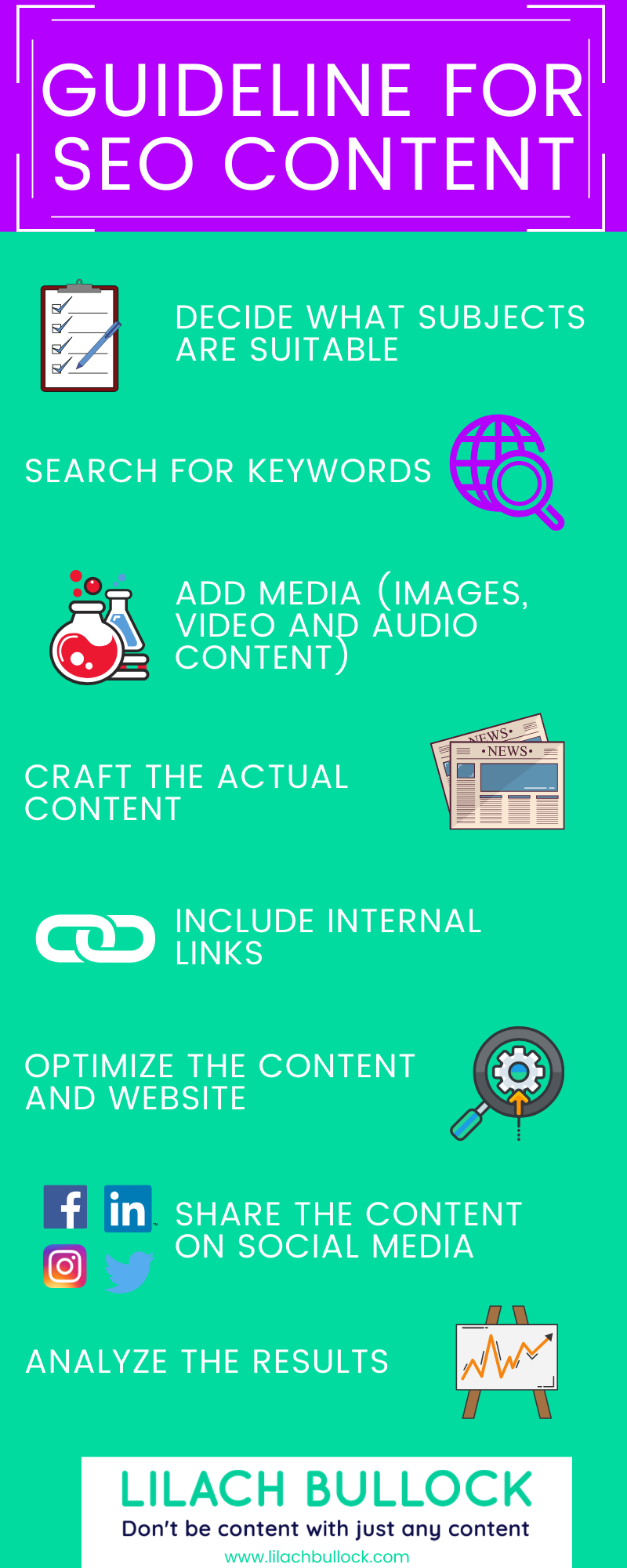 As I have mentioned earlier, SEO won’t work without content and vice versa. At this point, search engines consider content as one of the top-ranking factors. Besides, it is a known fact that if you publish content on a regular basis, you can bring more traffic to your website or blog. So, why is SEO important for your content? Here are the main reasons why:
As I have mentioned earlier, SEO won’t work without content and vice versa. At this point, search engines consider content as one of the top-ranking factors. Besides, it is a known fact that if you publish content on a regular basis, you can bring more traffic to your website or blog. So, why is SEO important for your content? Here are the main reasons why:
- During an online search, people usually click on one of the first five links that appear as results. If you want more traffic on your website or blog, it must be recognized as a top result by search engines.
- Ranking high on search engines can also make your site more trustworthy.
- A good SEO strategy can improve website usability and user experience.
- SEO can help with social media post sharing. If your site is listed on the first page for a specific keyword search, then your content is more likely to get social shares.
- You can outsmart your competition through SEO content.
An SEO strategy is based on several important rules to offer relevant info for search engine algorithms and crawlers. For example, the Google ranking algorithm evaluates a site’s quality through hundreds of factors, which can be grouped as:
- Technical SEO – optimizes the crawling and indexing phase of a website. It is not related to the content posted on a site. This process helps crawlers scan your website or blog without any difficulties.
- On-page SEO – optimizes the actual content of your site like headlines, structure, keywords and more. It offers crucial information to search engine crawlers so they can read each page of the site.
- Off-page SEO – also called link building, refers to a website promotion method. Pages with backlinks from other trusted websites are more visible to search engines than those with no links. That’s where link building outreach and guest posting merge into creating a valuable SEO strategy.
In this guide, we deal with SEO content, which represents a part of the on-page SEO process. How to write SEO content? Just like the complete SEO strategy, the SEO content writing process can be accomplished by following some basic rules. Here is a list of several SEO content types:
- Blog posts – this is an easy way to implement SEO on content. You can develop an engaging text that will help you build website authority.
- Product pages – this type of content can be at the same time a PPC or Pay Per Click landing page and an SEO content page.
- Articles – here, you can choose between interviews, news articles or featured pieces. If you have a magazine, this is the best choice for you.
- Guides – as long-form content, guides can be a great way to attract visitors. They are easy to optimize and great high-ranking opportunities.
- Listicles – people love to read lists. Listicles are another form of an article but created as a list of numbered entries about certain subjects. They are greatly appreciated by search engines.
- Videos – this form of content attracts a lot of people. Most of them would choose to watch a video than to read a text. You can develop tutorials for products or services or explanation videos for some of your articles.
- Slideshows – several images gathered in a gallery. Just like videos, images are most likely to engage consumers. Great images that offer detailed information about a topic or a story would bring more views to your website.
- Infographics – the new image trend. Besides the actual photo, an infographic provides text knowledge on a certain subject. They are the most shareable pieces of content.
 Let’s take a look over the most important steps for writing SEO content:
Let’s take a look over the most important steps for writing SEO content:
Step 1: Define the subject of your content
First, you need to identify a subject to write about. It has to be related to your target audience, to deliver a clear message to potential customers, and the information they are seeking. For fresh content ideas, take a look at these possibilities:
- Competition content – what does your competition have to say? What subjects are they covering? Take a peek over their content and see if you have missed a spot or if you could do better.
- Buyer persona – think of several types of potential customers. What are they like? What type of content would seem engaging to them? Create them and then do the math.
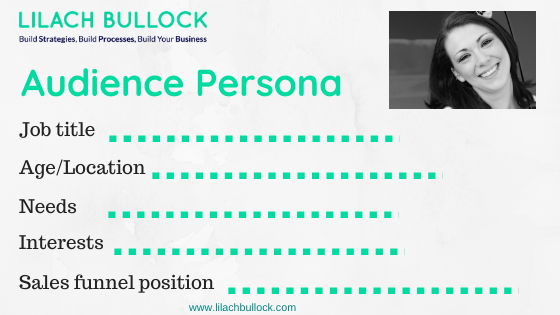
- Quora – the questions posted on this website are a good place to start. Find out what your target audience wants to know by following the types of questions they are asking.

- 9Gag – what started as a funny gifs and memes website, became an interesting place to post interesting intel and chat based on that content. It is also a good place to find the latest trends in content interests.
 Besides, the content should also be related to your businesses’ industry. You have to describe your courtyard to the outside world, not the other way around. For example, if you are selling computer hardware components, then you’ll create high-quality content based on this field with possible links to software and PC games.
Besides, the content should also be related to your businesses’ industry. You have to describe your courtyard to the outside world, not the other way around. For example, if you are selling computer hardware components, then you’ll create high-quality content based on this field with possible links to software and PC games.
Step 2: Keyword research
Keywords are the most important elements of SEO content. Without them, all your efforts mean nothing. This is the step where you have to create a list of the best keywords you can rank for on search engines. Good research can offer you an overview of what terms customers use. Based on this, you can select the ones that suit your brand and content. Even if it is called a keyword, it doesn’t mean you have to find a specific word and that’s all you get. A keyword can include multiple words like “Google Analytics plugin”, for example. Basic keyword research starts with Google Suggest. Here, you can find long tail keywords that people have already searched for a dozen times. 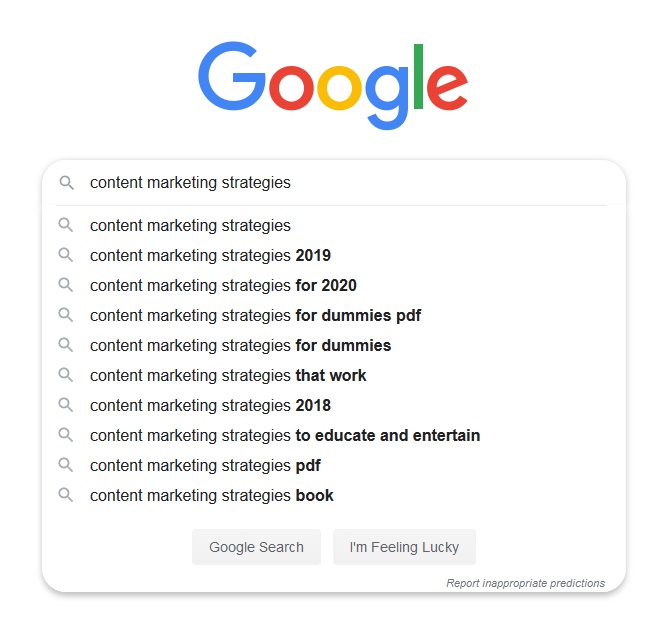 Then, you can try the Moz tool for a much more thorough exploration of your word or words. Here is an example:
Then, you can try the Moz tool for a much more thorough exploration of your word or words. Here is an example: 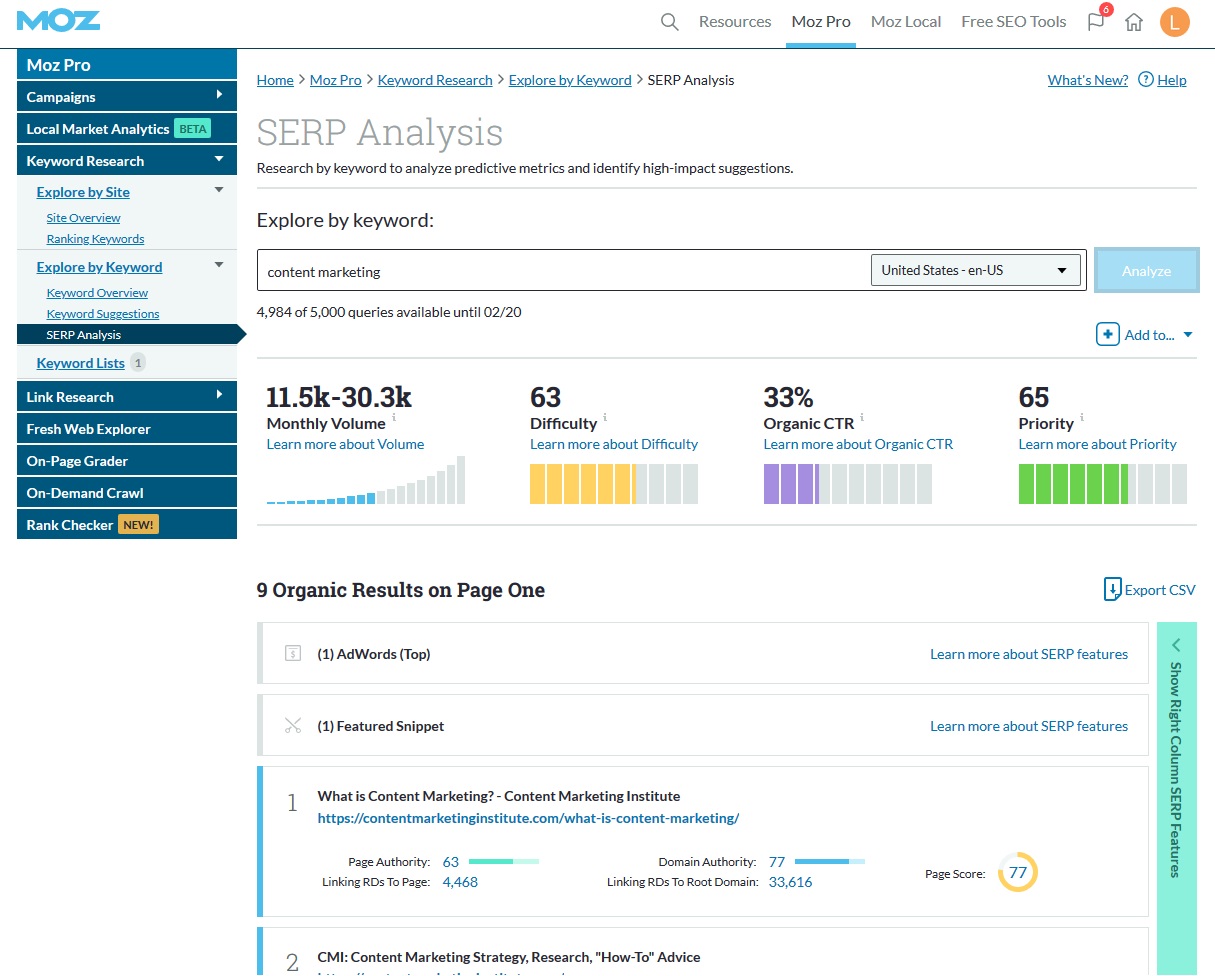 Or try the Ubersuggest free tool to see new ideas for your keyword and check out the average volume of searches in Google. Just type the keyword in the tab. Here is an example of what you can get:
Or try the Ubersuggest free tool to see new ideas for your keyword and check out the average volume of searches in Google. Just type the keyword in the tab. Here is an example of what you can get: 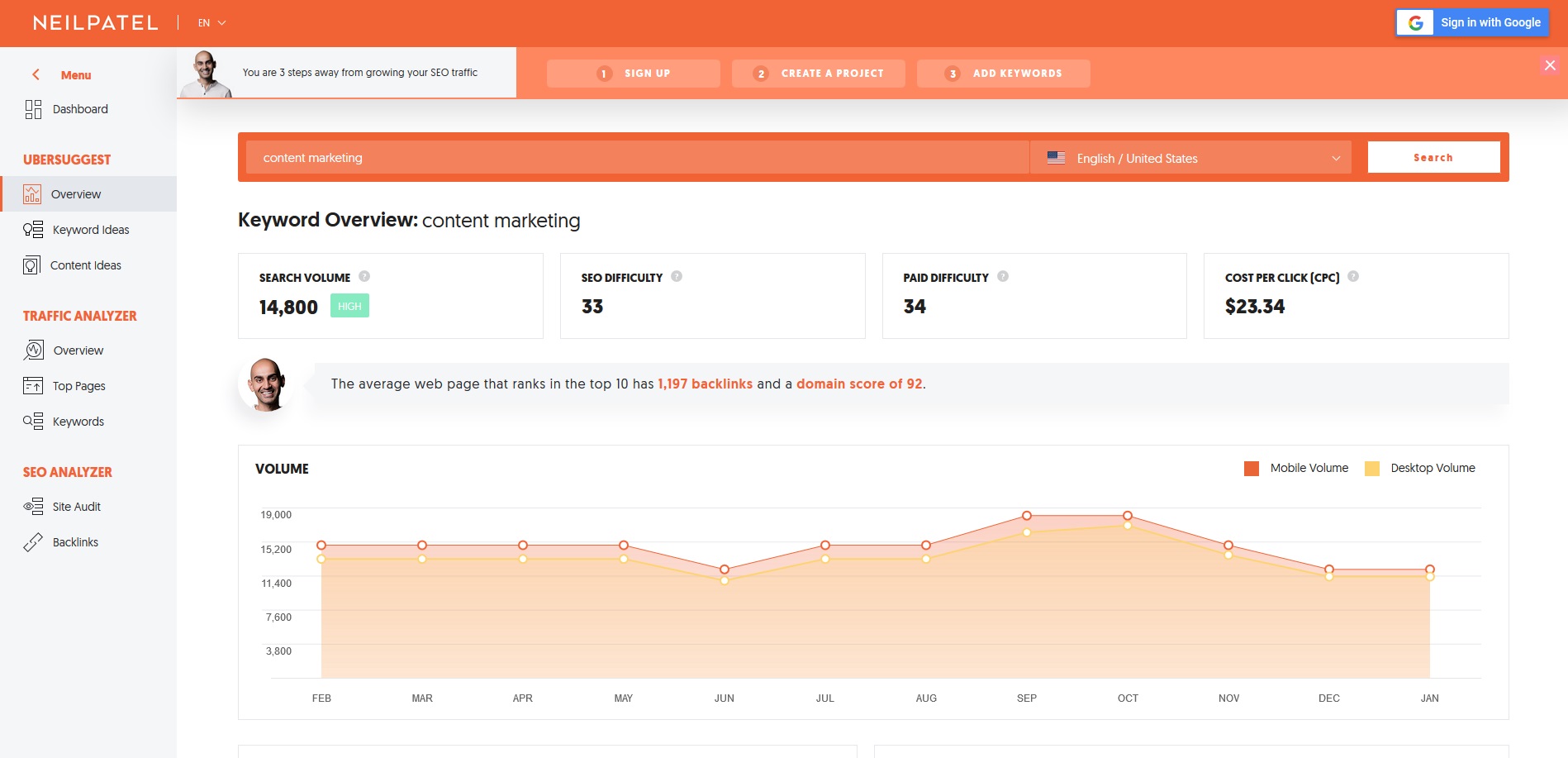 Besides, you can also check the AnswerThePublic online tool. It will offer you the most usable questions based on your words. These are the questions that were generated by the keyword “content marketing”:
Besides, you can also check the AnswerThePublic online tool. It will offer you the most usable questions based on your words. These are the questions that were generated by the keyword “content marketing”:  Keep in mind that keywords are like ammunition for rifles. Without them, the riffle won’t work. Here are some important steps to follow when you are diving for keywords: 1. At first, think of a few important words that suit your business. If you have a company that offers content marketing services, for example, you can choose words like content marketing strategies, content marketing services or content marketing prices.
Keep in mind that keywords are like ammunition for rifles. Without them, the riffle won’t work. Here are some important steps to follow when you are diving for keywords: 1. At first, think of a few important words that suit your business. If you have a company that offers content marketing services, for example, you can choose words like content marketing strategies, content marketing services or content marketing prices. 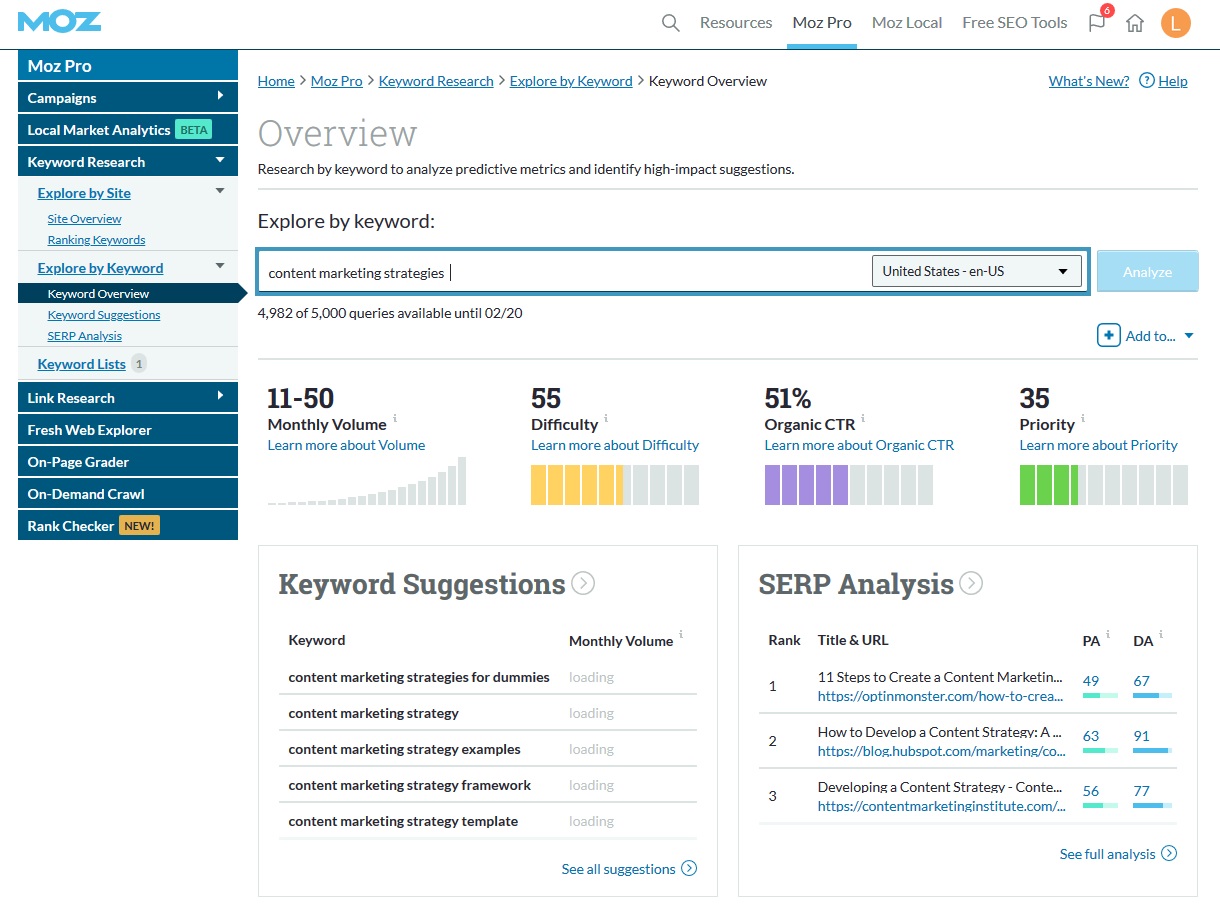 2. Think of your target audience. Are these keywords relevant to them? Would they search for something like this to find you?
2. Think of your target audience. Are these keywords relevant to them? Would they search for something like this to find you? 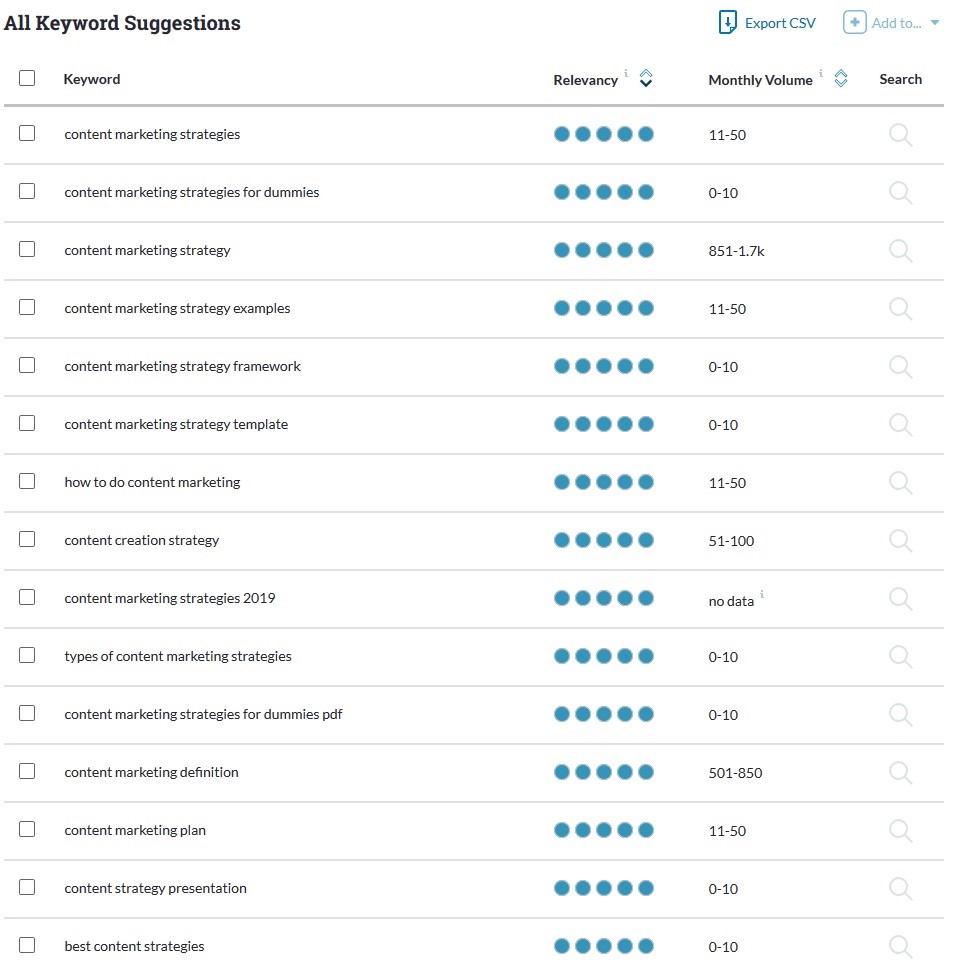 3. Analyze the search intent. Look at the results that Google generates for your keywords and see what people are searching for.
3. Analyze the search intent. Look at the results that Google generates for your keywords and see what people are searching for. 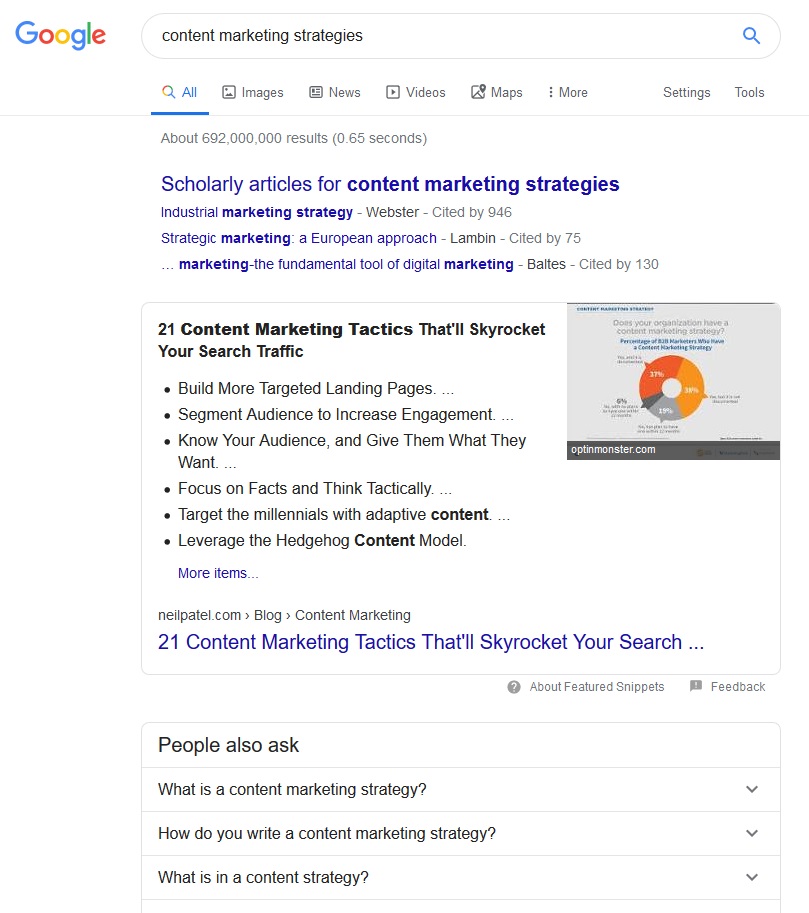 4. You should know that choosing a keyword can sometimes be difficult. If the first page in Google is full of high-popular content results from your niche, then you can’t rank for the same keyword. In this case, you have to think of other options. Maybe a variation of the keyword.
4. You should know that choosing a keyword can sometimes be difficult. If the first page in Google is full of high-popular content results from your niche, then you can’t rank for the same keyword. In this case, you have to think of other options. Maybe a variation of the keyword. 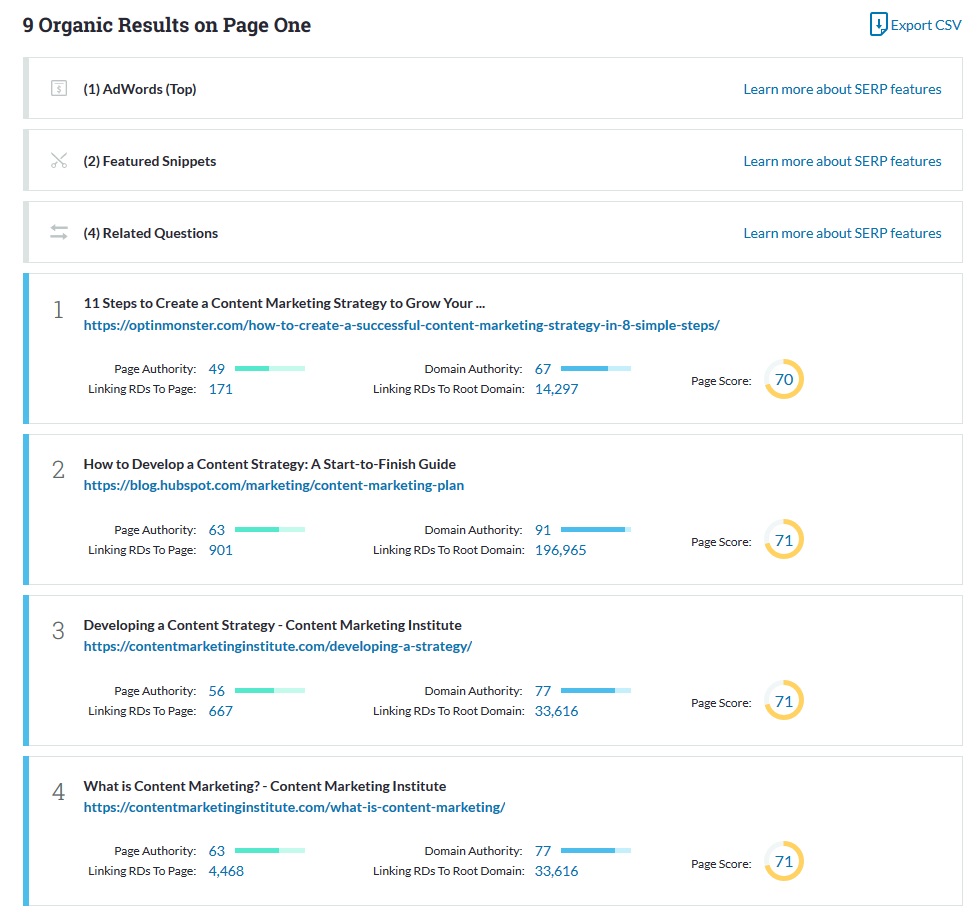 5. You could also think of the quality of that specific keyword. How many times was it searched by the audience? Are you able to rank for it? Make a list with all the keywords and key questions that you have found and analyze it. See what you can use to rank high on search engines. Then comes the next step, creating the actual content.
5. You could also think of the quality of that specific keyword. How many times was it searched by the audience? Are you able to rank for it? Make a list with all the keywords and key questions that you have found and analyze it. See what you can use to rank high on search engines. Then comes the next step, creating the actual content.
Step 3: Write relevant and clear content
The way you choose to write your content is very important. If you want great search engine ranking, you have to come up with awesome content that can beat anything else online. Those days of pointless keyword stuffing are long gone. Now, every keyword should fit right in the phrase, without changing its meaning or seem thrown in there for the sake of search engines. Nowadays, search engines prefer comprehensive content. Ending up on the first page on search engines is hard, but not impossible. Recent studies have shown that the short-form content between 300 and 500 words you were used to is no longer appreciated by search engines. Not like before anyway. 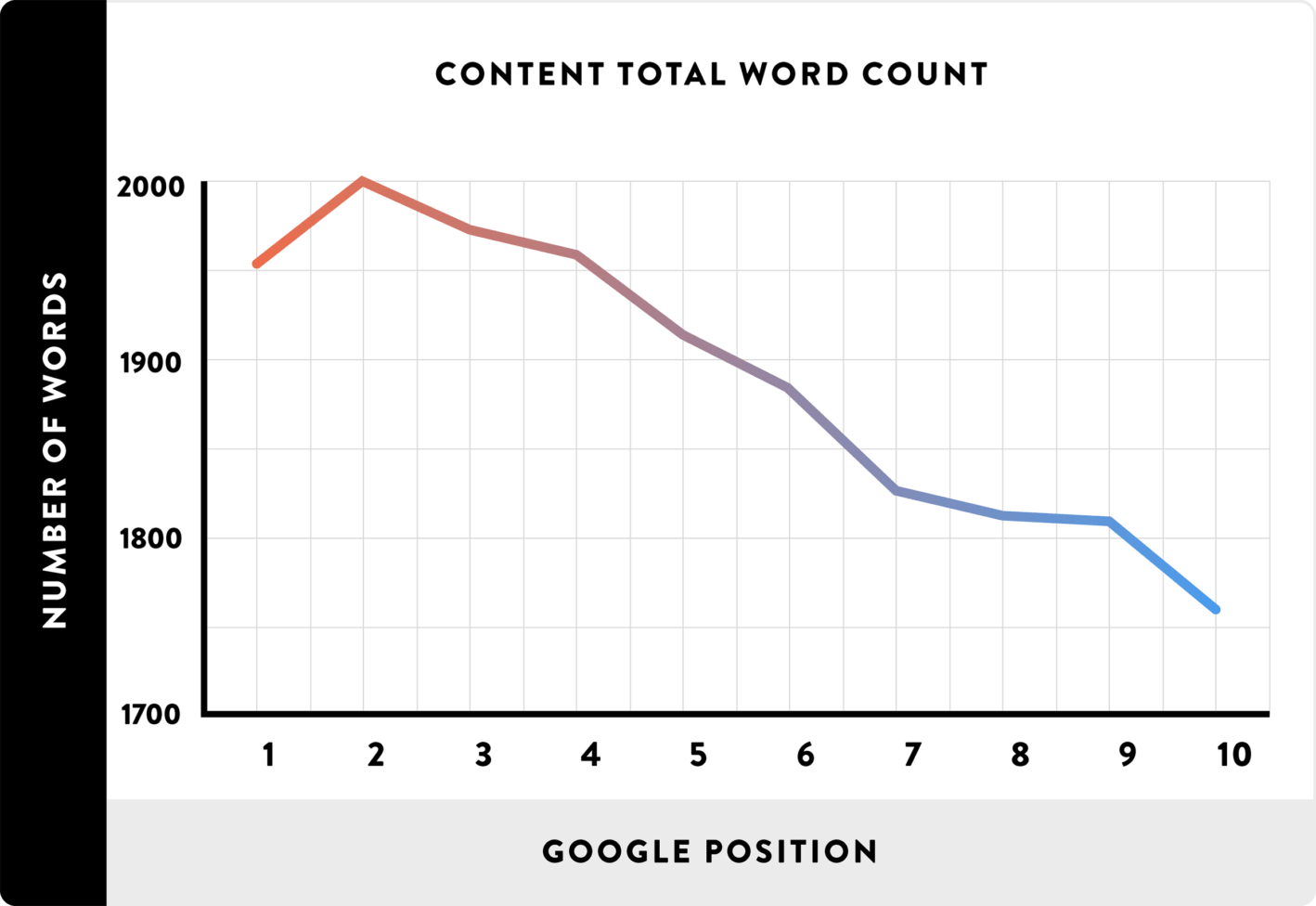
Source: https://backlinko.com/seo-content
Besides, search engines love long-form content. This is because they can gather more information about a certain subject, see that it is relevant to that search and bring it forward as a trustworthy source. As the above graphic shows, a post between 1,900 and 2,000 words can be exactly what you need to reach the top. Another important thing to remember. To create a useful piece of content with keywords, you have to follow these rules:
- Place the keyword in the first 100 or 150 words of your text.
- Use it in the title.
- Include it in your first H1 or H2 tag.
- It should be present in at least one subheading, an H2 tag more exactly – depending on the length of your content
- It should be mentioned more than once in a piece of content; once again, the ideal number of times you use a keyword depends on the length of your content
To have high-quality content, you must know this:
- Stick to a clear, educative, trustworthy, and relevant content that offers all the missing pieces.
- Focus on your target audience when you create content.
- Make sure people can share it easily.
- To make it readable, use of bold text, short paragraphs, bullet-point lists, quotes, images and so on.
- Create catchy titles and great subheadings.
- Create better content than your competitors.
- Don’t make grammatical mistakes.
- Use only reputable sources to link to.
- If you are enlisting facts, make sure they are checked before you include them.
Now, here’s how to optimize your content for users: Step 4: Content and keyword optimization As I mentioned earlier, writing amazing content is simply not enough. You also have to optimize it for your users. This means you need to make it readable and easily understandable or search engines won’t pick it up. With Google’s focus on the User Experience Signals besides the traditional ones, it’s hard to deliver complex content and also rank higher without proper content optimization. First off, you can try using short and concise sentences at the beginning of your piece of content. You can do the same throughout the rest of the text. This can help you ease the reading process and get the audience to pay more attention to the content. Multimedia is the second important thing to use. From images to videos, infographics, charts, whatever brings more value to your content. According to HubSpot, 20 percent of the audience will read the content, but 80 percent of them prefer to watch a video instead. The longer your content is, the better it is to split it with subheadings. This will not only make the content more readable, but it will also look better. Each subheading should be edited with an H2 or H3 tag. 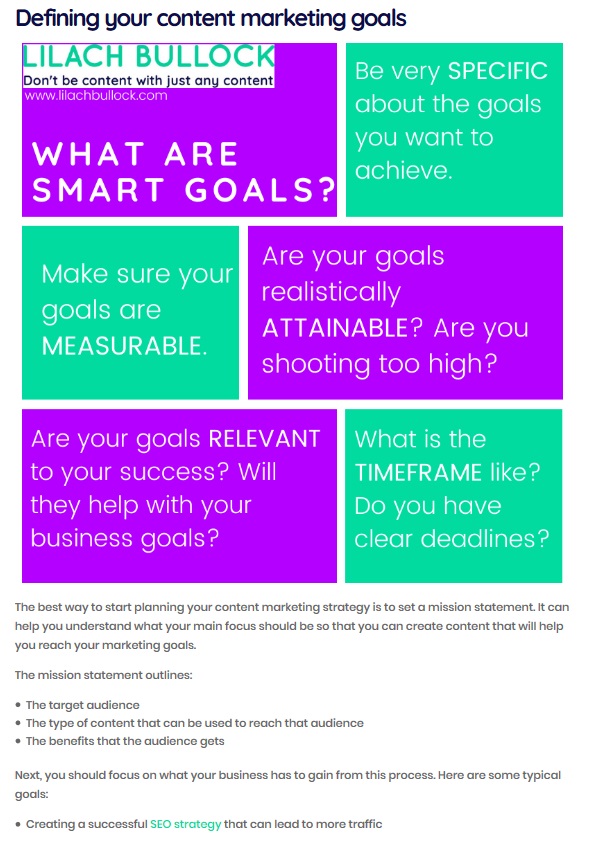 Edit your text so that the final piece meets these minimum requirements. This is the first step to achieving top rankings on search results. Search engines have become harder to please nowadays. They are only offering higher rankings by focusing on more specific aspects than before. So, in order to optimize your content with the right keywords, you should do this:
Edit your text so that the final piece meets these minimum requirements. This is the first step to achieving top rankings on search results. Search engines have become harder to please nowadays. They are only offering higher rankings by focusing on more specific aspects than before. So, in order to optimize your content with the right keywords, you should do this:
- Change the link of the post into a shorter version. For example, from https://www.lilachbullock.com/how-to-develop-a-content-marketing-strategy-an-ultimate-guide/ into https://www.lilachbullock.com/content-marketing-strategy-guide/. Short URLs are good for SEO.
- Include the main keyword of your content in the URL of the page.
- Try to use LSI or Latent Semantic Indexing keywords throughout your content. These related terms can help you rank better in search engines. They can be found in Google, at the bottom of the search page, after you search for a keyword. The LSI keywords are the ones in bold. For example, for my search on “content marketing strategies”, here is what Google gave me:
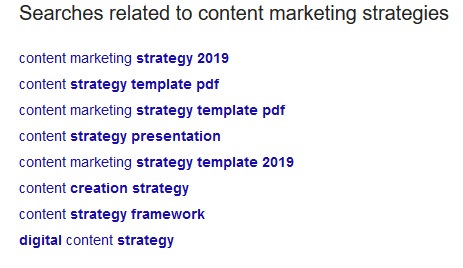
- Besides adding the keyword in your title, make sure you optimize it for CTR or Click-Through Rate. Search engines give a higher ranking to the most clickable titles of pages or articles. To achieve this, you can include in your headline: numbers, parentheses, and brackets.
- Add at least two outbound links in your articles. They should be representative of the subject, like authority resources.
- Include a minimum of two and a maximum of five internal links to older articles from your website. Choose suitable links that you would like to get a higher position on search engines as well.
- Increase your website speed if you believe it can load faster through great hosting packages.
Next, you should consider promoting your content on social media networks:
Step 5: Social media sharing
Social media networks should represent an important part of your SEO content process. You should focus on posting your content as soon as you get it live on your website. Regular content promotions on social media can get you great online visibility. Think of it as a boost for your content. Besides posting on your site and waiting for it to be discovered by consumers, you can also share it on multiple social media networks so more people can see it quickly. While there are tons of users on these platforms, it is impossible not to be observed. If you add up a subject of great interest in your niche, you’ll get a lot of views in no time. The networks you choose to post on are up to you. For example, you can find us on all major social networks 🙂 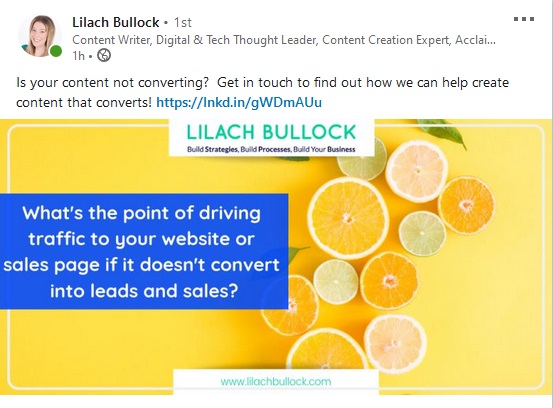
Step 6: Link building
Backlinks are still considered an amazing opportunity to get a higher ranking on search engines. The main goal should be to gather links from relevant, high-quality websites back to your articles. 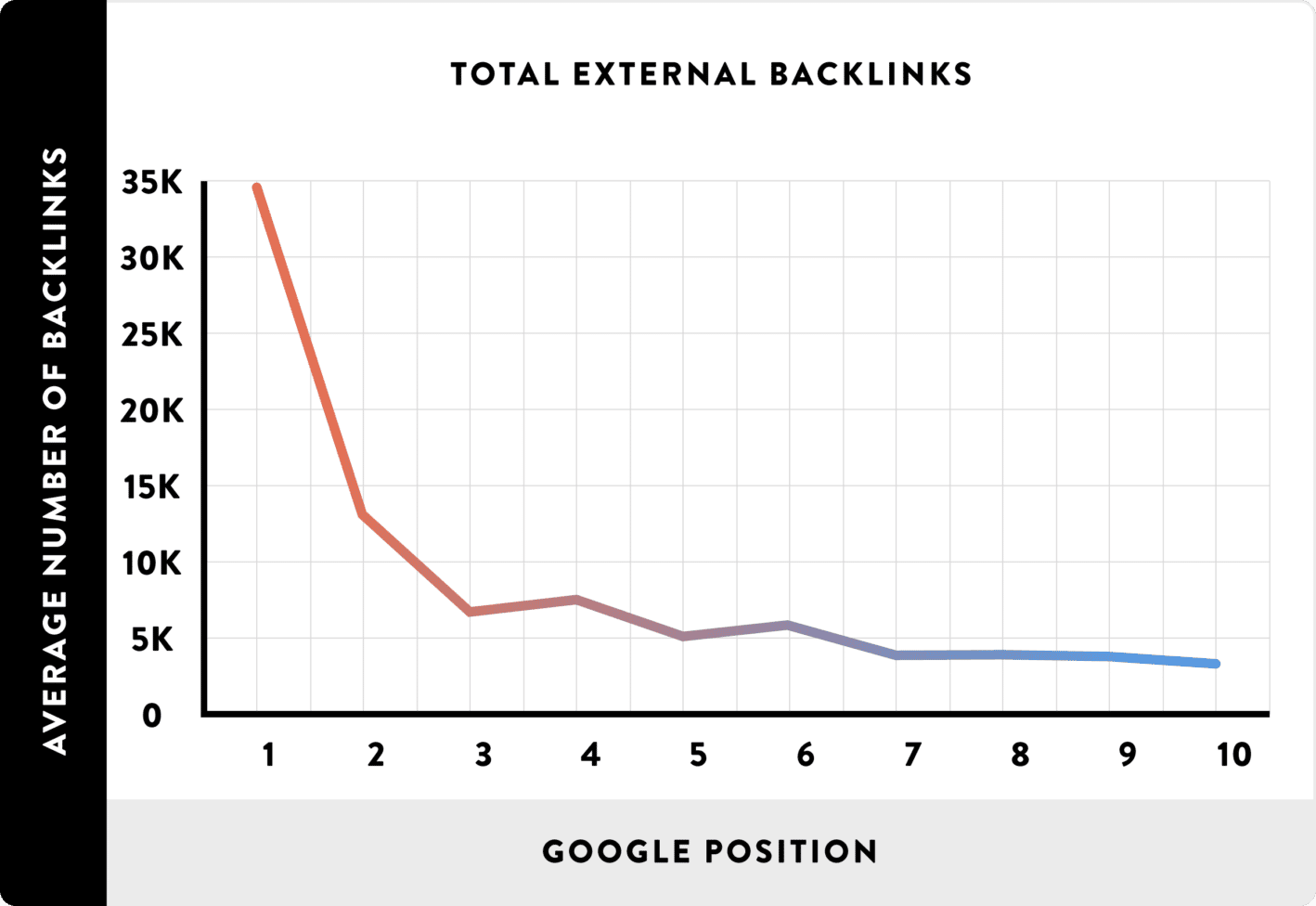
Source: https://backlinko.com/high-quality-backlinks
To manage that, follow these steps:
- Search on Google for one of your keywords and see what pages appear first. It seems that those articles are the best ones that exist on that subject.
- Based on that subject, create a piece of content that outstands the existing ones.
- Promote your newly created content to companies or people that are already mentioned in your post.
- Work hard to be listed as a source by bloggers and reporters. Gather as much authority blogs and websites backlinks as you can. HARO is a website you can use to get in touch with reporters and share your knowledge:

- You can also search for outdated links like companies that have moved on new websites, but people are still linking to them. At this point, you can send them an email and show them that the link has changed and gently offer one of your suitable pieces of content to link back to.
- Focus on a few types of content that are more likely to get backlinks like videos, quizzes, how-to content, infographics, and listicles.
- Create ultimate guides. They are considered backlink magnets mainly because they contain a lot of information about a specific subject on one page.
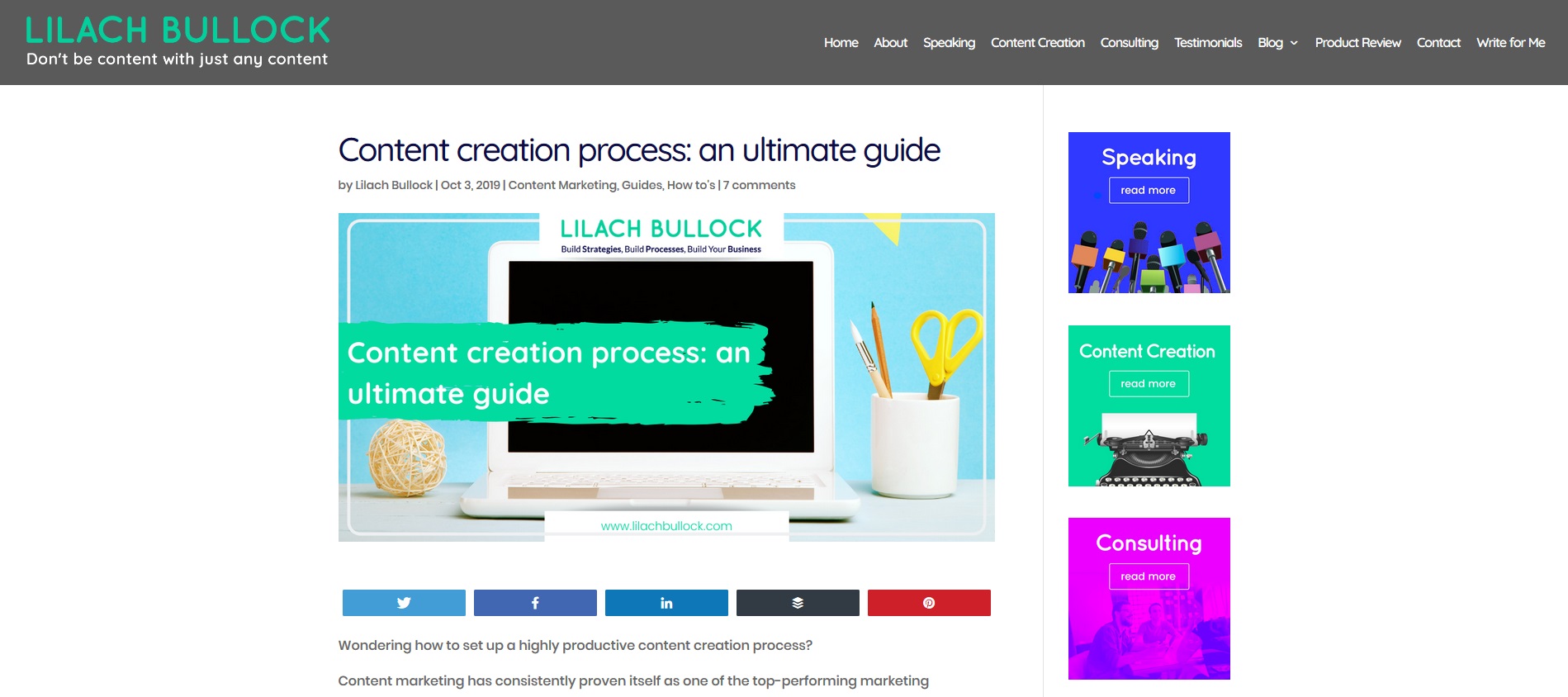
- If you discover a new method or strategy related to your field, naming it would be a great step. Then, start using the new name in your content. Ultimately, people will link to your content and mention your branded strategies or techniques.
- Search for mentions of your brand that don’t contain your link. Send a friendly email to the person or company that mentioned you in their comment and ask them kindly to add your link along with your brand.
All of these steps can offer results if you know how to implement them. Pay attention to details. Sometimes it can be the best choice you have in certain circumstances.
Step 7: Results analysis
After you have finished implementing your new SEO content strategy, you have to see what you have managed to accomplish. This step is about analyzing your results and monitoring them regularly. Here, you can use Google Analytics to discover how high you are ranking in search engines and see the organic traffic. Verify your content performance and the website traffic you have got once the SEO strategy starts working. Another great tool that might help you visualize your SEO results is Google Search Console. It can show you the performance of your website with a total number of clicks and impressions, the average CTR and the average position in search results.  Besides, it can also show you:
Besides, it can also show you:
- The most important queries people searched for.
- Your website pages with most clicks and impressions.
- The countries from where you had visitors.
- The number of clicks and impressions per type of device like mobile, desktop, and tablet.
- The number of clicks and impressions per certain dates.
You have to know that SEO does not bring results in 2 hours. It might be a while until you see something moving, but don’t panic. Continue to apply the SEO content scheme to all your content and check daily for its results.
Conclusion
If you want to be successful online, SEO content is a must. This is how you improve your visibility online, get more targeted traffic to your website and perhaps most important, generate more leads and conversions. Want an expert to create SEO-friendly content that can improve your content marketing ROI? Reach out to us here to see how we can help.

Follow Lilach















